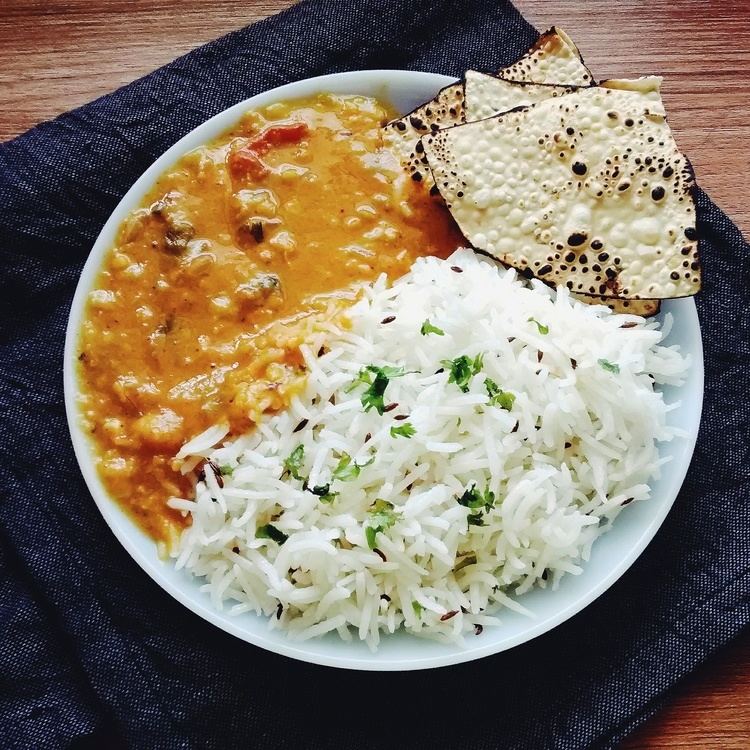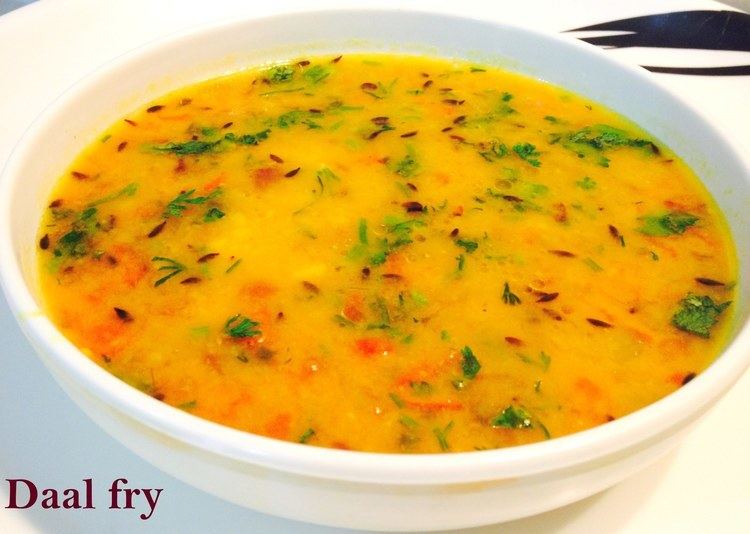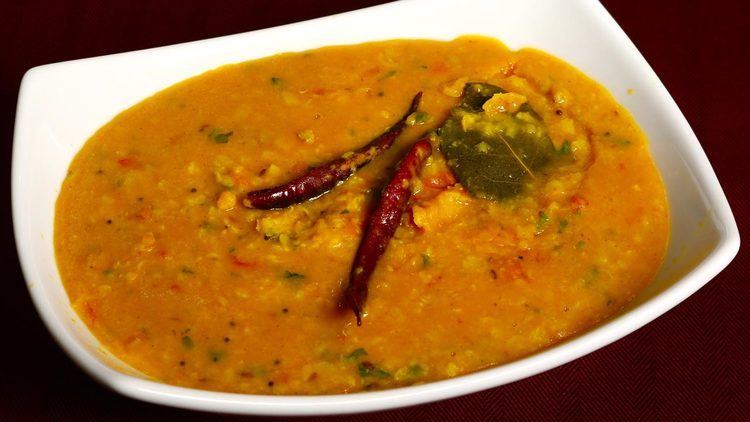 | ||
Similar Masala, Lentil, Chickpea, Paneer, Mung bean | ||
Indian food tarka dal how to cook easy food recipe
Dal (also spelled daal or dhal; pronunciation: [d̪aːl]) is a term in the Indian subcontinent for dried, split pulses (that is, lentils, peas, and beans). The term is also used for various soups prepared from these pulses. These pulses are among the most important staple foods in SAARC countries, and form an important part of Indian, Nepalese, Pakistani, Sri Lankan and Bangladeshi cuisines.
Contents
- Indian food tarka dal how to cook easy food recipe
- Punjabi toor dal fry easy cook with food junction
- Etymology
- Use by region
- Proteins
- Minerals and vitamins
- Common varieties
- Split and whole pulses
- Preparing dal
- References

Dals are frequently eaten with flatbreads such as rotis or chapatis or with rice, a combination referred to as dal bhat. Dals are high in protein relative to other plants.

The outer hull is usually stripped off; dal that has not been hulled is described as chilka (skin), e.g. chilka Urad dal, mung dal chilka in Hindi/Urdu. The term dal is often contrasted with the term gram, used in South Asia for pulses that are whole rather than split.

Punjabi toor dal fry easy cook with food junction
Etymology
The word dāl derives the Sanskrit verbal root dal- "to split".
Use by region
Dal preparations are eaten with rice, as well as rotis, chapati and naan on the Indian subcontinent. In India, it is eaten with rice and with a wheat flatbread called rotta. The manner in which it is cooked and presented varies by region. In South India, dal is primarily used to make the dish called sambar. It is also used to make pappu that is mixed with charu and rice.
Proteins
Its protein contents are 3.5 times that of rice and 2.5 times that of wheat. It provides an excellent source of protein, particularly for those adopting vegetarian diets or diets which do not contain much meat. It is typically around 25% protein by dry weight, giving it a comparable protein content to meats. However, by weight, cooked (boiled) dal contains 9% protein, 70% water, 20% carbohydrates (includes 8% fiber), 1% fat. Note that as extra water is added to cooked lentil, as in the case of sambar, proportion of proteins and other nutrients will reduce further. Protein contents of cooked lentil are one third that of cooked chicken. Most dals (except soybean, being exceptionally higher) have a similar amount of protein.
On its own, soybean is the only vegetarian complete protein. All other dals including pigeon pea do not have individual amino acids within protein in ideal proportion (unlike eggs and meats). However, if the proteins in dals are combined with rice or wheat (for example, chapatis), it provides amino acids in the right proportions, making it a complete protein. Bioavailability of proteins from dals is less than those from eggs and meats.
Note: Carbohydrates do not include fiber. Source:https://ndb.nal.usda.gov/
Note: Average daily protein requirements are 55 grams per person.
Ch. = Choline; Ca = Calcium; Fe = iron; Mg = Magnesium; P = phosphorus; K = Potassium; Na = Sodium; Zn = Zinc; Cu = Copper; Mn = manganese; Se = Selenium; %DV = %Daily value i.e. % of DRI ( Dietary reference intake ) Note : All nutrient values including protein are in %DV per 100 grams of the food item. Significant values are highlighted in light Gray color and bold letters. Cooking reduction = % Maximum typical reduction in nutrients due to boiling without draining for Ovo-lacto-vegetables group
Minerals and vitamins
It is also rich in the B vitamins thiamine and folic acid, as well as several minerals, notably iron and zinc. Note that absorption of this iron is reduced by about 65% if tea is consumed immediately after meal. This is important for vegetarians since tea reduces iron absorption from all plant sources including dal significantly. Iron absorption can be increased by about up to 85% by having vitamin C rich foods such as Guava or Orange juice along with meal. Vitamin C contents of lentils can be increased up to 10.5 times by sprouting. (See sprouting).
Ch. = Choline; Ca = Calcium; Fe = Iron; Mg = Magnesium; P = Phosphorus; K = Potassium; Na = Sodium; Zn = Zinc; Cu = Copper; Mn = Manganese; Se = Selenium; %DV = % daily value i.e. % of DRI (Dietary Reference Intake) Note: All nutrient values including protein and fiber are in %DV per 100 grams of the food item. Significant values are highlighted in light Gray color and bold letters. Cooking reduction = % Maximum typical reduction in nutrients due to boiling without draining for ovo-lacto-vegetables group Q = Quality of Protein in terms of completeness without adjusting for digestability.
Common varieties
Split and whole pulses
Although dal generally refers to split pulses, whole pulses and split pulses, whole pulses can be referred to as sabit dhal and split pulses as dhuli dhal.. The hulling of a pulse is intended to improve digestibility and palatability, but as with milling of whole grains into refined grains, affects the nutrition provided by the dish, reducing dietary fibre content. Pulses with their outer hulls intact are also quite popular in India and Pakistan as the main cuisine. Over 50 different varieties of pulses are known in India and Pakistan.
Preparing dal
Most dal recipes are quite simple to prepare. The standard preparation begins with boiling a variety of dal (or a mix) in water with some turmeric, salt to taste, and then adding a fried garnish at the end of the cooking process. In some recipes, tomatoes, tamarind, unripe mango, or other ingredients are added while cooking the dal, often to impart a sour flavour.
The fried garnish for dal goes by many names, including chaunk, tadka and tarka. The ingredients in the chaunk for each variety of dal vary by region and individual tastes. The raw spices (more commonly cumin seeds, mustard seeds, asafoetida, and sometimes fenugreek seeds and dried red chili pepper) are first fried for a few seconds in the hot oil on medium/low heat. This is generally followed by ginger, garlic, and onion, which are generally fried for 10 minutes. After the onion turns golden brown, ground spices (turmeric, coriander, red chili powder, garam masala, etc.) are added. The chaunk is then poured over the cooked dal.
